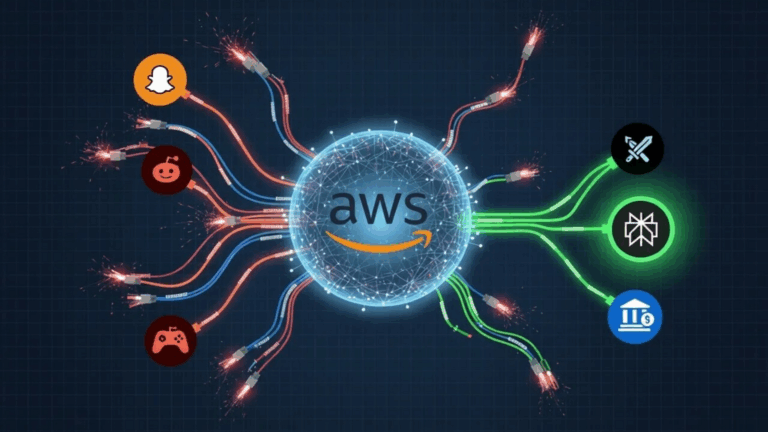This DNS issue meant that software trying to connect to DynamoDB couldn’t find it; not because the database was offline, but the system responsible for translating human-readable names into machine-usable Internet Protocol (IP) addresses had stopped functioning properly. Application requests failed, retries spiked and global services got disrupted, hitting everything from apps such as Snapchat and Signal to government services.
To understand the implications, it helps to look at how DNS works. At its core, DNS is the internet’s phone book. When you enter a web address like ‘amazon.com,’ DNS translates that into a numeric IP address so your browser can locate the correct server. This involves a chain of lookups: from the root servers to top-level domain servers, such as those for a ‘.com’ address, to the authoritative server for the specific domain.
This structure is overseen by the Internet Corporation for Assigned Names and Numbers (ICANN), the non-profit that manages the DNS root zone, delegates top-level domains and accredits registrars. ICANN is on top of the domain name hierarchy. While it had no direct role in AWS’s outage, its position underscores a broader point: the DNS is built on a centralized architecture, and centralization means the risk of a failure cascade, which is what occurred.
The DNS resolution for the DynamoDB API endpoint in US-East-1 failed, leaving dependent services unable to locate the database. Because the DNS is assumed to ‘just work,’ most systems are not built to handle its failure. But if it breaks, it breaks everything above it.
The DNS has several flaws. Its hierarchical nature creates single points of failure. The entire process can collapse if any step in the resolution chain fails due to a mis-configuration, overload or software bug. The AWS outage made these weaknesses painfully visible.
It showed how even internal DNS services, which cloud providers like AWS use for communication between their resources, can act as bottlenecks. In this case, the failure was in AWS’s own name resolution infrastructure within US-East-1. Even services inside AWS couldn’t reach DynamoDB because internal pointers had disappeared.
Some technologists see safety in blockchain-based alternatives, often grouped under Web 3.0. These systems aim to decentralize name resolution, side-stepping the control of ICANN. Projects like the Ethereum Name Service, Handshake and Unstoppable Domains use distributed ledgers for domain records. Users can register names on-chain and those records are secured by consensus mechanisms rather than a single registry.
In theory, this has significant advantages. A decentralized system would be harder to censor or take down. If no organization is in charge, there’s no central point of failure. Names and records live across thousands of nodes rather than a handful of root servers. This could prevent outages like AWS’s from spreading if a single node fails.
But reality complicates the picture. Blockchain-based naming systems are still niche, experimental and largely disconnected from DNS infrastructure. Most devices, browsers, and operating systems don’t support these systems natively. You need plug-ins, gateways or specific blockchain clients to resolve these names. The user experience is fragmented and performance trade-offs—especially for high-speed web traffic—remain significant.
Even if these technologies had matured, they wouldn’t have prevented the AWS outage. The failure didn’t occur at the public DNS layer, but within its internal network. For a blockchain-based name resolution system to help, AWS must redesign its internal service discovery architecture for decentralized use, a massive undertaking.
Still, chief among the lessons to be drawn is the danger of geographic and logical centralization. US-East-1 has long been a lynchpin of AWS’s infrastructure, hosting customer applications and many internal control services. Reversing this over-concentration offers a path toward resilience.
A more robust future might combine both approaches. Traditional DNS could incorporate ideas from decentralized systems, such as cryptographic verification, distributed resolution and independent registries, without abandoning compatibility. Cloud providers like AWS could adopt multi-region service discovery, independent failover paths and redundant name resolution layers that don’t depend so heavily on a single region or naming service.
The AWS outage reminds us of network vulnerability. When DNS fails, it’s like address labels vanishing from every building in a city. The centralized infrastructure we rely on today is efficient, but brittle. Blockchain-based naming may not be the solution yet, but could help make outages like this less catastrophic, as services would no longer hinge on a single address book in a single place.
For now, the web will continue to run on DNS, governed by ICANN. But for a more fault-tolerant internet, we may need to rethink how we store data, how we name it and who keeps the list.
The author is co-founder of Siana Capital, a venture fund manager.
Images are for reference only.Images and contents gathered automatic from google or 3rd party sources.All rights on the images and contents are with their legal original owners.

